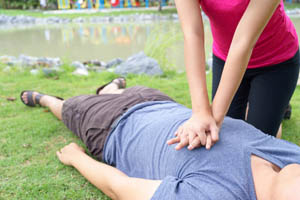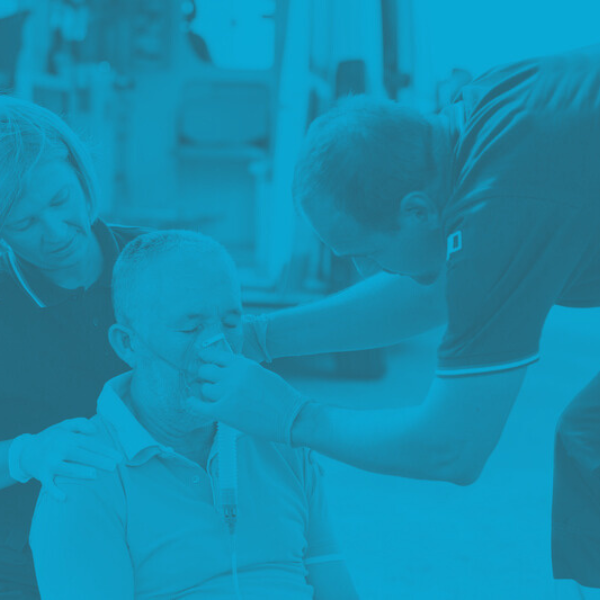How Hands Only CPR Increases Survival
How Hands Only CPR Increases Survival

by Greta Kviklyte
Life Saver, AMC
Co-authored by Kim Murray, RN, M.S.
posted on Dec 19, 2019, at 10:50 pm
Cardiac arrest prevalence remains a serious concern for health professionals and the public. According to the most recent American Heart Association (AHA) update, 366,807 people in the U.S. lost their lives due to cardiac arrest. Most importantly, most cardiac arrests occur outside of the hospital. Arrests most often occur in public settings (39.5%), residences (27.5%) and nursing homes (18.2%). Obviously, health professionals recommend conventional cardiopulmonary resuscitation (CPR) steps, as seen in the course here, at all times, but the risk of mortality increases when people fear making mistakes when administering CPR. To increase survival, hands only CPR is an acceptable alternative to witnessed, unexplained collapse or arrest.
We offer Online CPR and BLS Certification
The Difference Between Traditional CPR and Hands Only CPR
The difference between traditional CPR and hands only CPR is simple. Hands only CPR is a compression-only approach to helping a person survive a cardiovascular event. The AHA recommends pushing fast and hard in the center of the chest. This approach is applicable to all adults, but it does have a few important exclusions. Health professionals do not recommend the use of hands only CPR for infants, children and drowning victims. For these instances, conventional CPR is the Gold Standard.

Hands Only CPR training may vary slightly in the recommendations for approaching a victim. Those that do not suffer arrest in one of the above-listed events will benefit most from conventional resuscitation. However, for all cases where the victim is an adult and involved a witnessed collapse, the use of hands only CPR is an acceptable, viable solution.
At the same time, it is important to note that just because a person is a drowning victim or under the age of 18, those without CPR training and unable to contact EMS should initiate chest compressions. While this goes against the current recommendations, any CPR is better than no CPR. In fact, additional studies have proven an increased rate of survival for hands only CPR compared to those that did not receive help until EMS arrives.
Why People Value Hands Only CPR
The effects of hands only CPR go beyond survival to the hospital. Even when someone suffers an out-of-hospital (OOH) cardiac arrest, their risk of survival drops dramatically. Those that receive CPR (46%) may survive, but the overwhelming majority, 75%, do not survive to discharge or suffer additional poor outcomes, including permanent brain injury, paralysis and more.
In addition, hands only CPR possesses a record of accomplishment that goes beyond conventional CPR for untrained individuals. In terms of survival, notes NCBI.NLM.NIH.GOV, those that received hands only CPR appear to have a higher chance of survival than those that received conventional CPR. In a group of 1,842 studied individuals, 33 more people survived past hospital discharge in the hands only group than the convention group.
Hands only CPR should never replace conventional CPR when a trained individual knows how to perform traditional CPR. These studies focus on untrained, bystander-initiated hands only CPR, not inclusive of past CPR training. As a result, anyone with experience and training has a duty to ensure the proper use of chest compressions and rescue breaths to increase survival chances.
Among bystander-initiated responses, those without appropriate CPR training often underperformed rescue breaths, rendering the use of such breaths meaningless. The distinction means even those that attempted to perform rescue breaths were unsuccessful and effectively interrupting chest compressions without purpose.
Populations Served by Hands Only CPR Training
Anyone without formal CPR training will benefit from hands only CPR education. Due to its simplicity, anyone capable of recognizing a person’s collapse and physically able to push down in the center of the chest can perform hands only CPR. In fact, the use of hands only CPR has garnered attention around the globe, and researchers in Sweden have studied it in relation to other forms of CPR outside of the hospital setting. In OOH arrests, as few as 40% of victims do not receive CPR. Approximately 39% received conventional CPR, and 20% received compressions only. In the time period of 2000 to 2005, 2006 through 2010, and 2011 through 2017, during which Sweden began to roll out the use and recommendation of hands only CPR to the masses, arrest survival rates grew significantly, says ScienceDaily.com.
Throughout all focus periods, standard CPR rates continued to climb. Between the first and second phases, standard CPR rates in OOH arrests grew 9.4%. However, the biggest jump included the use of hands only CPR throughout all phases, moving an astonishing 28.2% over the 17-year period for any bystander-initiated CPR. At the end of the third period, hands only CPR rates had grown more than 25% as well.
The study further found that recipients of hands only CPR had a 200% increase in survival chances beyond 30 days. Researchers do note; however, that any form of CPR—even when incorrectly performing rescue breaths—is more effective than simply waiting for EMS to arrive.
The Science Behind Hands Only Resuscitation
The science behind hands only CPR goes back to the pre-arrest oxygen levels within the body. A person may enter arrest for a variety of reasons, ranging from hypothermia to tachycardia. A lack of oxygen remains the biggest threat when someone enters cardiac arrest, and since oxygen is in the lungs, why not take advantage of it?
The use of hands only approaches effectively “buys some time until someone comes to get the heart started again, says Dr. Clifton Callaway, vice chair of emergency medicine at the University of Pittsburgh Medical Center via Reuters. Oxygen remains in the lungs when a person collapses, and the principles of diffusion of oxygen across the membranes in the lungs continue. The compressions replace the physical mechanism of the heart—pumping blood through the body and to the organs.
An additional advantage exists within hands only approaches. Eliminating the need to reposition the head, check for signs of respiration, and feel for a pulse means people can begin life-saving measures faster—a critical concern for 911 operators walking someone through the steps to respond. Also, hands only CPR is an effective way to perform life-saving measures when fear of bloodborne pathogens, as seen here, is an issue.
Common Questions About Hands Only Resuscitation
Those interested in learning more about hands only CPR and its use may have some questions, including:
How Long Does Hands Only CPR Really Work
 Hands only CPR is not a long-term solution to arrest. It requires responders contact EMS or other trained health professionals as soon as possible. As an interim solution, bystanders must never rely solely on hands only CPR to restore a person’s circulation for periods beyond the typical EMS response time. If anyone in the vicinity comes forward with training and knowledge of how to perform conventional CPR, switch to the inclusion of rescue breaths and appropriate responses. Unfortunately, no study exists to determine the exact length of time a person may maintain circulation and oxygenation of tissues with hands only resuscitation. However, that fact must not dissuade bystanders from providing hands only CPR.
Hands only CPR is not a long-term solution to arrest. It requires responders contact EMS or other trained health professionals as soon as possible. As an interim solution, bystanders must never rely solely on hands only CPR to restore a person’s circulation for periods beyond the typical EMS response time. If anyone in the vicinity comes forward with training and knowledge of how to perform conventional CPR, switch to the inclusion of rescue breaths and appropriate responses. Unfortunately, no study exists to determine the exact length of time a person may maintain circulation and oxygenation of tissues with hands only resuscitation. However, that fact must not dissuade bystanders from providing hands only CPR.
Do the Principles of Hands Only CPR Work for Choking Victims
Hands only CPR is advised for when people collapse without explanation. If someone collapses while eating, choking is the most likely cause. This is where hands only CPR and choking intervention begin to mirror one another. If a person chokes and loses consciousness, the advised steps include attempting rescue breaths. If the breaths do not go in, guidelines advise for the initiation of chest compressions. The compressions serve a dual purpose, forcing enough air through the trachea to dislodge an object and maintain circulation. Without appropriate oxygenation, a person will enter cardiac arrest, so still, hands only CPR may be necessary additional trained EMS personnel arrive.
Does EMS Still Need to Be Contacted When a Person Regains Consciousness
Any incidence of cardiac or respiratory arrest warrants a visit from EMS. Even if the person regains consciousness and does not wish to see a health professional, always contact EMS. This is the best course of action, and if the cause of arrest is left unchecked, it may recur.
What About Special Circumstances, E.G., Obesity or Pregnancy
The use of hands only CPR for special circumstances, such as obese individuals or pregnant women, remains the same. In both cases, the person performing compressions should move the placement of the hands further up to the middle of the chest. This allows for sufficient chest recoil and avoid risking injury to either an unborn child or pushing unnecessarily into fatty tissue.
Does a Person Still Need to Check for a Pulse in the Steps to Hands Only CPR
Not really, but this is a point of debate in hands only approaches. By definition, hands only CPR is used when a person collapses without reason, and it involves avoiding all delays. So, it is reasonable to not check for a pulse when responding. More importantly, taking extra time to feel for a pulse adds to the delay and could lead to poor outcomes.
How Do I Know How to Push Fast Enough
Pushing fast enough is another concern. The easiest way to ensure compression rates of 100 to 120 beats per minute is to think of a few songs with similar rhythms. For example, reports Today, these songs have a beat that works well with the advised compression rate:
- Stayin’ Alive by the Bee Gees
- Dancing Queen by ABBA
- Hard to Handle by the Black Crowes
- Sweet Home Alabama by Lynyrd Skynyrd
- I Will Survive by Gloria Gaynor
- Crazy in Love by Beyoncé and Jay Z
- Just Dance by Lady Gaga
- Hips Don’t Lie by Shakira
Of course, any song with similar steps or rhythm will work, so those concerned about compression rates should consider reviewing the beats of their favorite songs to find one that’s easy to remember.
Gain the Power to Save Lives With the Most Basic Form of Care—Hands Only CPR
Saving lives is a major undertaking, and bystanders have a responsibility to act when someone suffers cardiac or respiratory arrest. While society grew comfortable with the idea of some trained individuals, the need for more intervention became clear. Today, the use of hands only resuscitation is a viable option and saves lives, especially when compared to not receiving CPR at all.
Have you ever had to perform hands only CPR? If so, share your thoughts and this article to social media now. Also, if you’d like to further your skills, consider enrolling in an online, conventional CPR course, such as the one available here.



